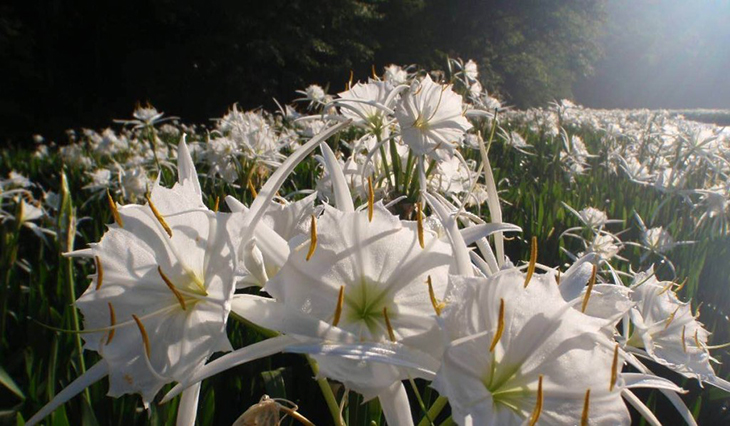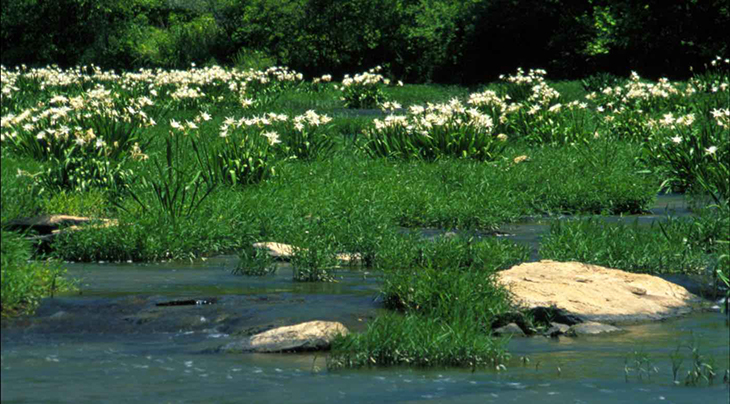
Most people see coal mining as a way to destroy habitats and pollute water, especially down in the middle of Alabama. But thankfully, due to the state’s Abandoned Mine Land Reclamation program, something beautiful has sprouted out from the so-called ashes, a wildlife refuge of natural beauty that’s brought thousands of tourists to come in troves in order to be able to take photos of this rare yet gorgeous white lily.
20 years ago, the state managed to acquire the land, but in doing so, manager Steven Trull, who happens to run the Cahaba River National Wildlife Refuge, also shares that they acquired a problem as well. However, lately, he also shares that there has been a magnificent transformation in the area that has happened quite quickly.
He explains, “Being able to clean it up and stop the chemicals from going into the Cahaba River is a wonderful thing on so many levels.”
The Cahaba River is considered to be an ecological marvel in Alabama, considering this river has been dumped upon, badly degraded, and dammed up. The river flows from springs and cascades 190 miles to the Alabama River. Around three-fourths of the river happens to be free-flowing, which is also the longest stretch of unblocked river in the state of Alabama as well. As it goes beyond Birmingham, the Cahaba river flows through the rolling hills, which also marks the end of the Appalachian Mountains, showing up rocky shoals that are along the river’s upper portions without any riverside development in that area.

Moreover, the Cahaba is also home to an incredible amount of fish species, which no other river in North America of the same size can claim. In fact, around fifty of the continent’s 300 types of mussels can be found in the river as well, with around 10 percent of North America’s gill-breathing freshwater snail species too.
But these weren’t the stars of the river, but actually the white Cahaba lily – also known as the shoals spider-lily – that drew such huge crowds of nature enthusiasts.
While the flower is considered rare, it’s not yet federally threatened or endangered so to speak. Yet it was spoken about by 18th century naturalist William Bartram who said that “nothing in vegetable nature was more pleasing.”
The Cahaba River was actually named after these lilies, and they usually bloom around spring. Because of how beautiful they are, people from far-off Canada and even Upstate New York travel there just to see it. Although these fragrant white lilies don’t bloom very long – with each flower opening overnight and lasting for just one day – the actual show of these new flowers would last anywhere between six to eight weeks at a time.
The lilies are usually all gone by mid-June, which also means that the tourists that come to see them have pretty much gone as well with plans to return the following year to wait, camera in hand, for their next bloom.
There is even a Cahaba Lily Festival yearly, which happened to attract around 1,000 carloads of people during the last festival. But for Manager Steven Trull, he hopes that they can create a year-round recreation at the conservation preserve that sits south of Tuscaloosa city and Birmingham city.
The Hymenocallis coronaria also grows in the Carolinas and Georgia, since these states also have swift-moving waters, lots of sunlight, and rocky shoals that these lilies require to survive. This is also why the species is considered imperiled because of all the dams that have been built along the rivers.
This flower also reaches around 3 feet in height, or 0.9 meters, developing from a bulb that usually lodges itself in the cracks of the rocky shoals. They are also three inches wide with six petals, as well as nectar that is alluring to many pollinators.
How The Are Cleaning the Water
At least nine wastewater treatment plants are using the Cahaba River that sits between Birmingham and the refuge, but issues such as failing septic tanks, agricultural runoff, residential and industrial development contributed to the water-quality issues. Moreover, wildlife officials had no choice but to deal with the pollution that came from abandoned mining operations such as toxic chemicals, sedimentation, and heavy metals.
Currently, the refuge has 5,000 acres while that state also secured an additional $5 million in mine-reclamation money which is used to clean up the waste that comes from the mine. Alongside other partners, the refuge will also use another $735,000 in funding to help prevent wildfires, lessen woody undergrowth, which will benefit the native plants and longleaf pines as well.
Then in 2021, the Service also bought 1,164 acres of well-tended forest that sits on the river’s eastern bank. It was the Land and Water Conservation Fund that gave the $3.2 million to pay for the property, which in turn, parlays the earnings from gas leases and offshore oil into recreation projects and conservation.
Trull, who used to be a miner himself before, shared, “It’s got hunting access, new trails, canoeing, kayaking, fishing, wildlife observation – all sorts of recreation opportunities for the community.”
In addition, a beaver pond is actually below the Piper mines that are now sealed since the remains of the min are contaminated by sulfuric acid and runoff that filtered out and washed downhill. In order to stop this, a state agency has already closed up the pits and cleaned up some of the mess that was made from all these toxins. Now the plan is to clean up what’s left and restore it to its natural state. And with the amazing growth of the lilies, there’s hope that it won’t take too long to reach success.
What are your thoughts? Please comment below and share this news!
True Activist / Report a typo


